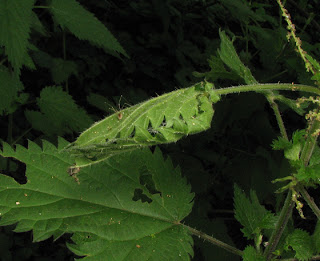
Bumble bee and jewelweed. © Beatriz Moisset
Some of your garden visitors are undeniably clever. Raccoons and squirrels come immediately to mind. But, bumble bees? How could pinheaded insects be capable of any intelligence? Those who study insects tell us that some are capable of remembering things and, even more amazingly, of learning new things and acting accordingly.
The one that gained a reputation as the Einstein of the insect world is the honey bee. Books have been written about its cleverness and the way it communicates with other members of the colony. Some other members of the six legged crowd also show surprising signs of memory and intelligence. Bumble bees, close relatives of honey bees, and also living in colonies composed of a queen and workers, are not far behind them.
If you enjoy spending some time looking at the visitors to your flowers, you may have a chance to see some examples of their braininess.
A tricolored bumble bee, a regular flower visitor
©
Beatriz Moisset
Perhaps, one morning you step into your garden, coffee cup in hand, and see a bumble bee on your flowers. The scene looks familiar; you have noticed it several times before. Could it be the very same bumble bee? There is a good chance you are correct. She, and it is usually a she, is good at memorizing the best business locations—the bushes or clusters of plants with abundant flowers and plenty of valuable resources. She is probably guided by a combination of clues to recognize the area: landmarks, the position of the sun, smells, perhaps even the magnetic field of the earth. Thus your friendly garden visitor develops a daily route; and even memorizes the timing of blooming, morning or afternoon to show up right on schedule. Researchers may learn all these things by painting a little dot of color on the back of the bee so they can follow its comings and goings.
 |
| Entering a jewelweed © Beatriz Moisset |
Another behavior worth watching is their routine when visiting a flower. I love to see them going inside a jewelweed and am always amazed at the speed with which they proceed. I wish they were a little slower and allowed me to take a few pictures. Learning how to deal with complicated flowers takes practice. A naïve bumble bee may refine her technique with time and the more complicated the flower, the more practice is required.
Bumble bee visiting a turtlehead © Beatriz Moisset
Researchers resort to interesting methods to unravel the mysteries of bumble bee behavior. For instance, they glue little tags of different colors to their backs so they can track down the activities of each individual. They test their ability to recognize flowers by offering them artificial flowers of different colors or different aromas; and filling only certain ones with nectar. The student bees learn to choose the flower of the right color or scent and bypass all others.
Enjoy your garden pollinators next season and see if you can recognize these behaviors and perhaps observe new ones.
More on Bumble Bees:
The Telegraph. Might of the bumblebee.Learning tests, yellow flowers vs. blue
Bumble Bees, Panda Bears of the InsectWorld
















